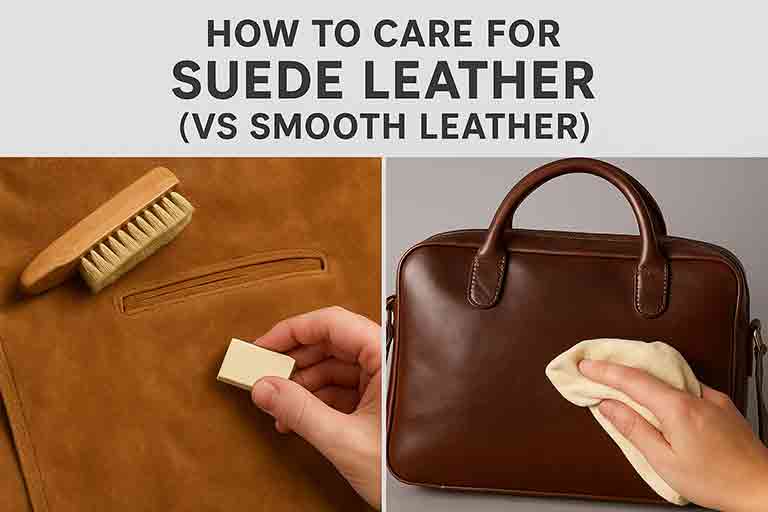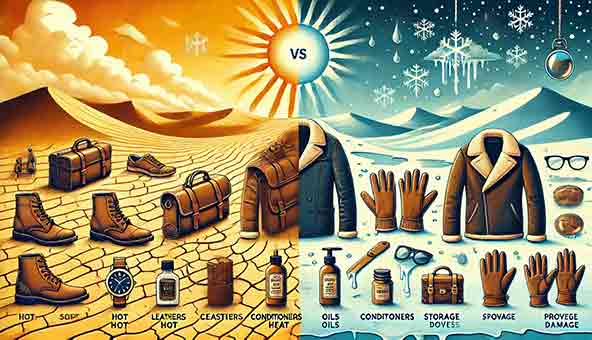
How To Clean A Leather Motorcycle Vest?
, by Syed Khawar Bukhari, 24 min reading time

, by Syed Khawar Bukhari, 24 min reading time
When it comes to owning a leather motorcycle vest, you understand the importance of looking the part while staying safe on the road. A well-maintained leather vest not only adds style to your riding gear but also serves as a protective layer against the elements. In this comprehensive guide, we will delve into the significance of keeping your leather motorcycle vest clean and why proper cleaning matters.
Your leather motorcycle vest is more than just a fashion statement; it's a piece of equipment that plays a crucial role in your riding experience. Here are some key reasons why keeping it clean is of utmost importance:
Leather vests are an investment, and like any investment, you want them to last. Proper cleaning and maintenance can significantly extend the lifespan of your leather motorcycle vest. Leather is a natural material, and without proper care, it can deteriorate over time. Regular cleaning helps prevent cracks, tears, and discoloration, ensuring that your vest remains in top condition for years to come.
Your leather vest is not just for style; it provides an additional layer of protection when you're out on the road. It can shield you from wind, debris, and even minor abrasions in case of a fall. A dirty or grimy vest may not perform as effectively in safeguarding you from these elements. So, ensuring it's clean is not just a matter of aesthetics but also a safety concern.
A clean leather vest is a comfortable leather vest. Accumulated dirt and sweat can make your vest uncomfortable to wear, especially on long rides. Cleaning your vest regularly ensures that it remains comfortable and breathable, allowing you to focus on the ride ahead.
Let's face it; a well-maintained leather vest looks great. It enhances your overall riding attire and boosts your confidence on the road. Whether you're cruising through the city or hitting the open highway, a clean leather vest is a statement of your style and commitment to the motorcycle culture.
Now that you understand the significance of a clean leather motorcycle vest, let's delve into why proper cleaning is essential.
Leather is known for its natural beauty and unique patina that develops over time. Proper cleaning helps retain this beauty by removing dirt, dust, and grime that can dull the leather's luster. Regular cleaning ensures that your vest continues to look stunning, making a statement every time you wear it.
Leather is susceptible to mold and mildew growth if exposed to moisture and left untreated. This not only damages the leather but also creates an unpleasant odor. Proper cleaning and drying methods help prevent mold and mildew from taking hold, preserving your vest's integrity.
A clean leather vest maintains its original color and texture. Without proper cleaning, leather can fade, and its texture can become rough and unattractive. Regular cleaning and conditioning keep the color vibrant and the leather soft and supple.
Accidents happen, and stains or blemishes on your leather vest are almost inevitable. However, with proper cleaning techniques and products, you can effectively remove or minimize these imperfections, keeping your vest looking flawless.
When it comes to leather motorcycle vests, not all leathers are created equal. Understanding the types of leather used in the construction of your vest is crucial for making informed decisions about its care and maintenance. Here are some common types of leather you might encounter:
Full-grain leather is the highest quality leather you can find in motorcycle vests. It is made from the top layer of the hide and retains the natural grain, giving it exceptional strength and durability. Full-grain leather is known for its rugged appearance and ages beautifully, developing a unique patina over time.
Top-grain leather is another popular choice for motorcycle vests. It is slightly thinner than full-grain leather and is sanded and treated to remove imperfections. While it may not be as durable as full-grain leather, top-grain leather is often more affordable and still offers good quality.
Split-grain leather is made from the lower layers of the hide and is less durable than full-grain or top-grain leather. It is often used in vests for its lightweight and breathable properties. However, it may require more care and maintenance to ensure longevity.
Genuine leather is the lowest quality among the options. It is made from layers of leather bonded together and is less durable than other types. While it can be budget-friendly, it may not withstand the rigors of motorcycle riding as well as higher-quality options.
To properly care for your leather motorcycle vest, it's essential to know its anatomy. Here are the key parts of a typical motorcycle vest:
The front panels of the vest cover your chest and torso. They often have a zipper or snap-button closure and may feature pockets or decorative elements.
The back panel of the vest extends from the shoulders to the lower back. This is where you can often find patches or embroidery showcasing your club affiliation or personal style.
The collar surrounds the neck and can vary in style, from a classic fold-down collar to a more modern mandarin collar.
Many motorcycle vests feature pockets, both inside and outside. These are handy for storing small items or essentials while riding.
Some vests come with a removable liner, which can provide extra warmth during colder rides. Liners are typically attached with zippers or snaps.
Before diving into cleaning and maintenance, it's essential to assess the current condition of your leather motorcycle vest:
Check for any visible damage, such as tears, scratches, or loose stitching. Identifying these issues early allows you to address them promptly.
Examine the vest for any stains, spills, or spots. Identifying stains can help you choose the appropriate cleaning methods and products.
Assess the leather's overall condition. Is it dry and stiff, or does it still feel supple? Understanding the leather's state will guide your conditioning efforts.
By familiarizing yourself with the types of leather, the parts of your vest, and its current condition, you're better equipped to care for and maintain your leather motorcycle vest effectively. In the next sections, we'll delve into cleaning, conditioning, and preserving your vest to ensure it remains a reliable and stylish companion on your rides.
Cleaning and maintaining your leather motorcycle vest is a crucial part of ensuring its longevity and appearance. To get started, you'll need the right cleaning supplies and equipment. Here's a breakdown of what you'll require:
Choose a high-quality leather cleaner specifically designed for motorcycle gear. Avoid using harsh chemicals or household cleaners, as they can damage the leather.
A good leather conditioner is essential to keep the leather soft and supple. Look for one that provides UV protection to prevent fading and cracking due to sunlight exposure.
If your vest has suede or nubuck elements, invest in a suede brush to gently clean and restore the texture.
Lint-free cloths or microfiber towels are perfect for applying cleaning solutions and buffing the leather to a shine without leaving lint behind.
A soft bristle brush, such as a horsehair brush, is excellent for removing loose dirt and dust from the leather's surface.
Sponges or applicator pads are useful for applying cleaning solutions and conditioners evenly across the leather.
For homemade cleaning solutions, a plastic spray bottle is handy for easy application.
If your vest has fabric liners, use a vacuum cleaner with a brush attachment to remove dirt and debris from the crevices.
Consider using a leather protection spray for an extra layer of defense against moisture and stains.
Safety is paramount when working with cleaning solutions and leather care products. Here are some precautions to keep in mind:
Always work in a well-ventilated space to avoid inhaling fumes from cleaning products.
Wear disposable or protective gloves to prevent skin contact with cleaning solutions, which may contain chemicals.
If you're using sprays or aerosol products, wear safety goggles or glasses to protect your eyes.
Before applying any cleaning solution or conditioner to your entire vest, test it in a small, inconspicuous area to ensure it doesn't cause any adverse reactions or discoloration.
Read and follow the manufacturer's instructions on all cleaning and conditioning products carefully.
By gathering these cleaning supplies and adhering to safety precautions, you'll be well-prepared to clean and maintain your leather motorcycle vest effectively. In the following sections, we'll guide you through the step-by-step process of cleaning and conditioning your vest to keep it looking its best.
Before you begin the cleaning process for your leather motorcycle vest, it's essential to prepare it properly. Here are the steps to ensure your vest is ready for cleaning:
If your vest has a zipper or buttons, start by unzipping or unbuttoning it. This will make it easier to access all areas of the vest during cleaning.
Carefully remove any patches, pins, or accessories from the vest. Place them aside in a safe location to prevent damage or loss.
Check all pockets and remove any items inside, such as coins, keys, or documents. Emptying the pockets ensures that you can clean them thoroughly.
Take a soft bristle brush, such as a horsehair brush, and gently brush the entire surface of the vest. This step helps remove loose dirt, dust, and debris that may have accumulated on the leather.
Focus on seams, crevices, and any textured areas where dirt may be trapped. Be thorough but gentle to avoid scratching the leather.
Before applying any cleaning product to the entire vest, choose a small, inconspicuous area (inside edge or pocket lining) to perform a patch test.
Follow the instructions on your chosen leather cleaner. Apply a small amount of the cleaner to the test area and allow it to sit for the recommended time.
After the specified time, check for any adverse reactions, such as discoloration or damage to the leather. If the test area looks unaffected, it's safe to proceed with cleaning the entire vest.
By following these steps to prepare your leather motorcycle vest, you ensure that it is free of accessories, patches, and loose debris, and you've tested your chosen cleaning products to avoid any potential damage. With your vest properly prepared, you're ready to move on to the actual cleaning and conditioning process, which will help maintain the quality and appearance of your beloved motorcycle gear.
Maintaining your leather motorcycle vest is crucial to keep it in top-notch condition. Cleaning the exterior surface, the interior lining, and addressing any odors are essential steps in this process. Here's how to clean your leather vest effectively:
Start by choosing a high-quality leather cleaner that matches the type of leather your vest is made of (e.g., full-grain, top-grain, or split-grain). Follow these steps:
Cleaning the interior lining of your vest requires a different approach, especially if it's made of fabric or has a removable liner:
To address odors in your leather motorcycle vest, consider the following:
Regular cleaning and proper care will ensure that your leather motorcycle vest remains in great condition, looking and smelling fresh. With these steps, you can confidently clean and maintain your motorcycle gear, extending its lifespan and keeping it stylish for years to come.
After cleaning your leather motorcycle vest, the next crucial step is to condition and protect it. Conditioning helps maintain the leather's suppleness, while protection ensures it remains resilient against the elements. Here's how to condition and safeguard your vest:
There are different types of leather conditioners available, and the one you choose should match the type of leather your vest is made from:
To preserve the color and shine of your leather motorcycle vest, consider using a leather protectant with UV-blocking properties:
To protect your leather motorcycle vest from water and the elements, consider a waterproofing spray or wax:
By following these steps to condition and protect your leather motorcycle vest, you'll ensure that it remains supple, maintains its color and shine, and is well-guarded against water and the elements. Proper care and maintenance will not only extend the life of your vest but also keep you looking stylish and protected while riding.
Leather motorcycle vests are not immune to wear and tear. Here are solutions to common issues you may encounter, ensuring your vest continues to look its best:
UV Protection: Prevention is key. Use a leather protectant or conditioner that offers UV protection to shield your vest from the sun's rays. Apply it regularly to maintain the leather's color.
Storage: Store your vest in a cool, dry place away from direct sunlight when not in use. Use a breathable cover to shield it from dust and light.
Dye or Leather Paint: If your vest has already faded, consider using a leather dye or paint in a matching color. Follow the product's instructions carefully and test in an inconspicuous area first.
Leather Conditioner: Apply a high-quality leather conditioner regularly to keep the leather supple and prevent it from drying out. Conditioning helps maintain flexibility and prevents cracking.
Avoid Heat: Keep your vest away from direct heat sources like radiators or heaters, which can accelerate leather drying and cracking.
Humidifier: If you live in a dry climate, consider using a humidifier in your storage area to maintain the leather's moisture balance.
Cleaning: If you discover mold or mildew on your vest, clean it immediately. Use a mixture of mild soap and water or a specialized leather cleaner. Test the cleaner on a small, inconspicuous area first.
Drying: Ensure your vest is completely dry before storing it. Hang it in a well-ventilated area to air out, and use a fan if necessary.
Prevention: To prevent future mold and mildew growth, store your vest in a dry, well-ventilated area and use moisture-absorbing products like silica gel packets or activated charcoal.
Identify the Stain: Determine the type of deep stain you're dealing with, whether it's oil, ink, or something else.
Stain-Specific Removers: Use a stain-specific remover or treatment. For example, use a leather degreaser for oil stains or a leather stain remover for ink stains. Follow the product's instructions carefully.
Patch Test: Always perform a patch test in an inconspicuous area before applying any stain remover to the stained area.
Patience: Deep stains may require multiple treatments. Be patient and persistent, repeating the process until the stain is completely gone.
By addressing these common issues with your leather motorcycle vest promptly and following these solutions, you can prolong the life of your vest and keep it looking great for years to come. Remember, regular maintenance and care are essential for preserving the quality and appearance of your motorcycle gear.
Your leather motorcycle vest is an investment, and with proper care, you can extend its lifespan, ensuring it serves you well on countless rides. Here's how to keep your vest in great shape for years to come:
Regular Cleaning: Clean your vest regularly, especially after rides in dusty or dirty conditions. Use a leather cleaner suitable for your vest's type of leather.
Spot Cleaning: Address spills, stains, or spots promptly. The longer a stain sits, the harder it is to remove.
Scheduled Conditioning: Condition your vest at least once every few months, even if you don't wear it frequently. Leather conditioners keep the leather supple and prevent drying and cracking.
Use Appropriate Conditioner: Choose a conditioner that matches your leather type. Cream conditioners work well for most leather vests.
Clean and Condition: Before storing your vest for the winter, make sure it's clean and conditioned. This helps prevent moisture damage during storage.
Use a Garment Bag: Store your vest in a breathable garment bag to protect it from dust and light while allowing airflow.
UV Protection: During the summer months, pay extra attention to UV protection. Use a leather protectant with UV-blocking properties to prevent fading.
Avoid Overexposure: Limit your vest's exposure to direct sunlight and heat, which can cause fading and drying.
Watch for Signs: Keep an eye out for signs of wear and tear, such as cracks or dryness in the leather.
Reconditioning: If you notice these signs, recondition your vest with a leather conditioner. Apply it more frequently until the leather regains its suppleness.
By following these steps for regular maintenance, seasonal care, and reconditioning when needed, you can ensure that your leather motorcycle vest remains in excellent condition and continues to serve you well on your rides for many years to come. Proper care and attention will not only extend its lifespan but also enhance your overall riding experience.
Once you've gone through the cleaning, conditioning, and maintenance processes, it's time to put the finishing touches on your leather motorcycle vest to make it look its best:
By reattaching patches and accessories with precision, polishing your vest if desired, and conducting a thorough final inspection, you ensure that your leather motorcycle vest is in pristine condition and ready for your next ride. These final touches add a personal touch to your gear and enhance your overall riding experience.
In conclusion, proper care and maintenance are essential to ensure the longevity and stylish appearance of your leather motorcycle vest. By cleaning, conditioning, and protecting it regularly, you can preserve the leather's quality and prevent common issues like fading and dryness. Additionally, following seasonal care and reattaching patches and accessories with care adds a personal touch to your gear. With attention to detail and a commitment to maintenance, your leather vest will continue to be a reliable and fashionable companion on your motorcycle journeys.


